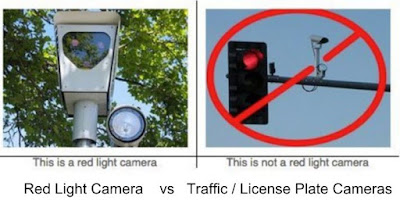Red light cameras are designed to take photos of vehicles that enter a specific intersection after the traffic light has turned red. If you enter the intersection before the light turns red, you are probably safe. Entering the intersection means that your front tires are across the white line while the line is yellow and turning red. If you cross the white line while the light is red that would trigger a flash and a violation.
How Do Cameras Work?
If you’re turning right at a red light, you could trigger the camera if you don’t stop and take the time to look both ways before moving into the intersection. Red light cameras are either mounted on a free-standing pole near the intersection and are rarely attached directly to the traffic light stand. When the light is red, sensors that are embedded under each lane of traffic trigger the camera when a vehicle drives over the stop line. Then, the camera snaps a photo of the vehicle’s rear license plate.
How Long Does It Take to Receive a Ticket?
Once the camera takes a photo of your license plate and driver, the picture is reviewed by a trained officer who makes sure you were actually running the red light. Within about a 5-7 business days, a ticket (ranging from $50 $500) is sent to the address listed on the vehicle’s registration.
Is This a Red Light Camera?
Many drivers mistake red light cameras for traffic cameras. Read our blog post and see our red light cameras map for the type of camera at an intersection.
What do red light cameras look like?
Other FAQ's
Q: How does a red light camera know when a violation occurs?
A: Inductive loops or radar sensors are embedded in the pavement just beyond the stop line. When the light turns red, the system is armed. If a vehicle passes over the sensors without stopping, the camera is triggered to record the violation.
Q: What does the camera capture?
A: Most systems take multiple high-resolution photographs and sometimes short video clips. These include:
-
The vehicle’s license plate
-
The vehicle in the intersection during the red phase
-
The traffic signal showing red
Q: Do red light cameras always flash?
A: Many cameras use a flash unit at night or in low-light conditions to clearly capture license plates. During the day, the flash may not be as noticeable, or newer cameras may use infrared technology that isn’t visible to drivers.
Q: How are violations reviewed?
A: After the camera records a potential violation, trained law enforcement staff review the images and video to confirm whether an infraction actually occurred before issuing a citation.
Q: Who receives the ticket—the driver or the vehicle owner?
A: In most jurisdictions, the citation is mailed to the registered owner of the vehicle. Some states allow owners to contest the ticket by proving someone else was driving.
Q: How long does it take to receive a ticket?
A: Typically, a ticket is mailed within 7 to 30 days after the violation, depending on the local laws and review process.
Q: Can you fight a red light camera ticket?
A: Yes. Defenses may include proving the light was still yellow when you entered, emergency maneuvers, or errors in camera calibration. Some cities also allow appeals if the vehicle was stolen or the driver was not the registered owner.
Q: Are warning signs required before intersections with red light cameras?
A: Many jurisdictions require posted signs to alert drivers, but the rules vary by state and city. Some places do not require any signage at all.
Q: Do red light cameras record continuously?
A: No. They are typically event-driven, meaning they only record when a violation is detected. They do not continuously monitor or film all vehicles.
Q: What happens if you don’t pay a red light camera ticket?
A: Consequences depend on the jurisdiction. Unpaid fines may result in late fees, collections, registration holds, or even a suspended license in some areas.
Q: Are red light cameras effective at reducing accidents?
A: Studies show mixed results. Some reports indicate a reduction in serious side-impact collisions, while others show an increase in rear-end crashes as drivers brake suddenly to avoid tickets.


